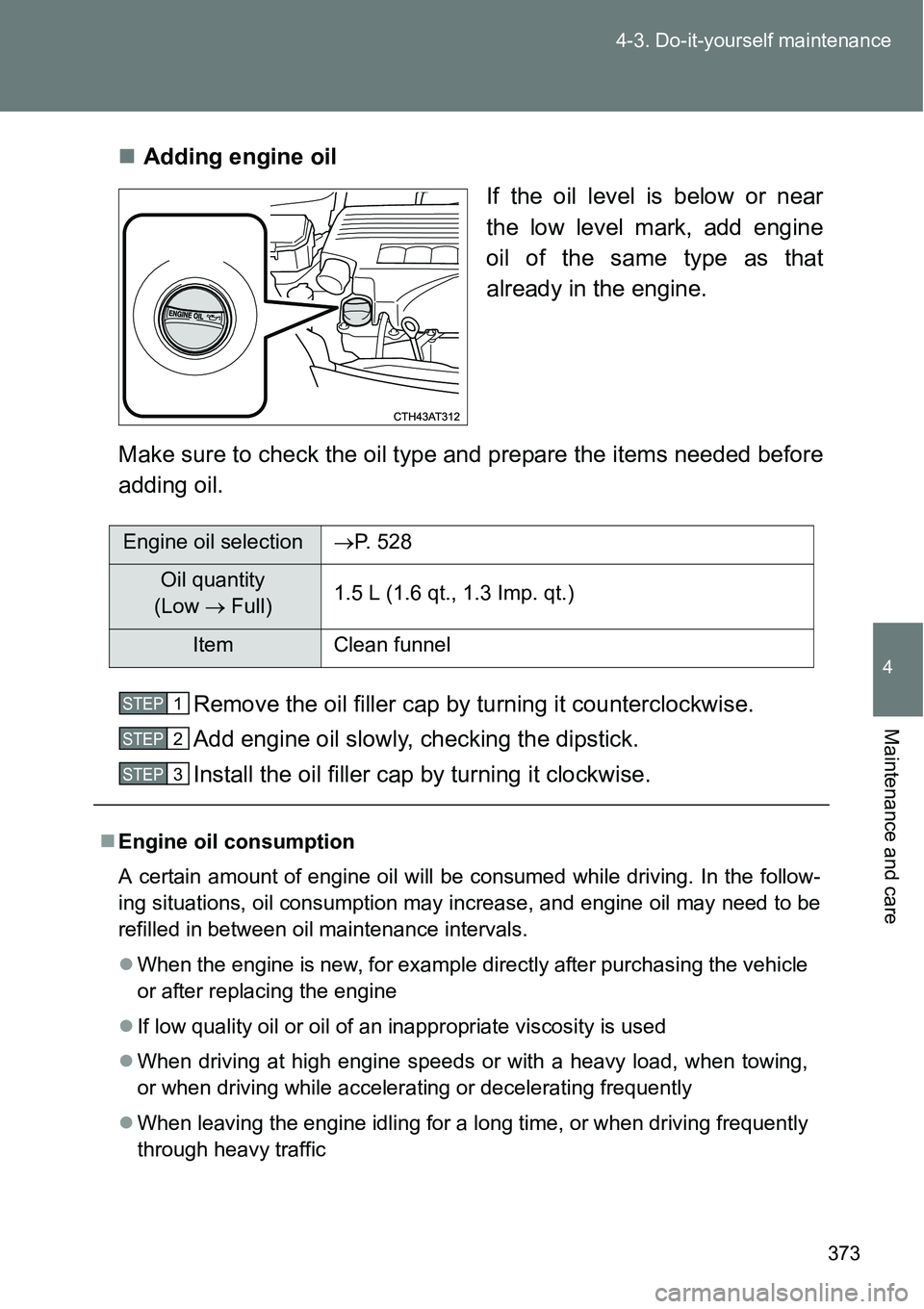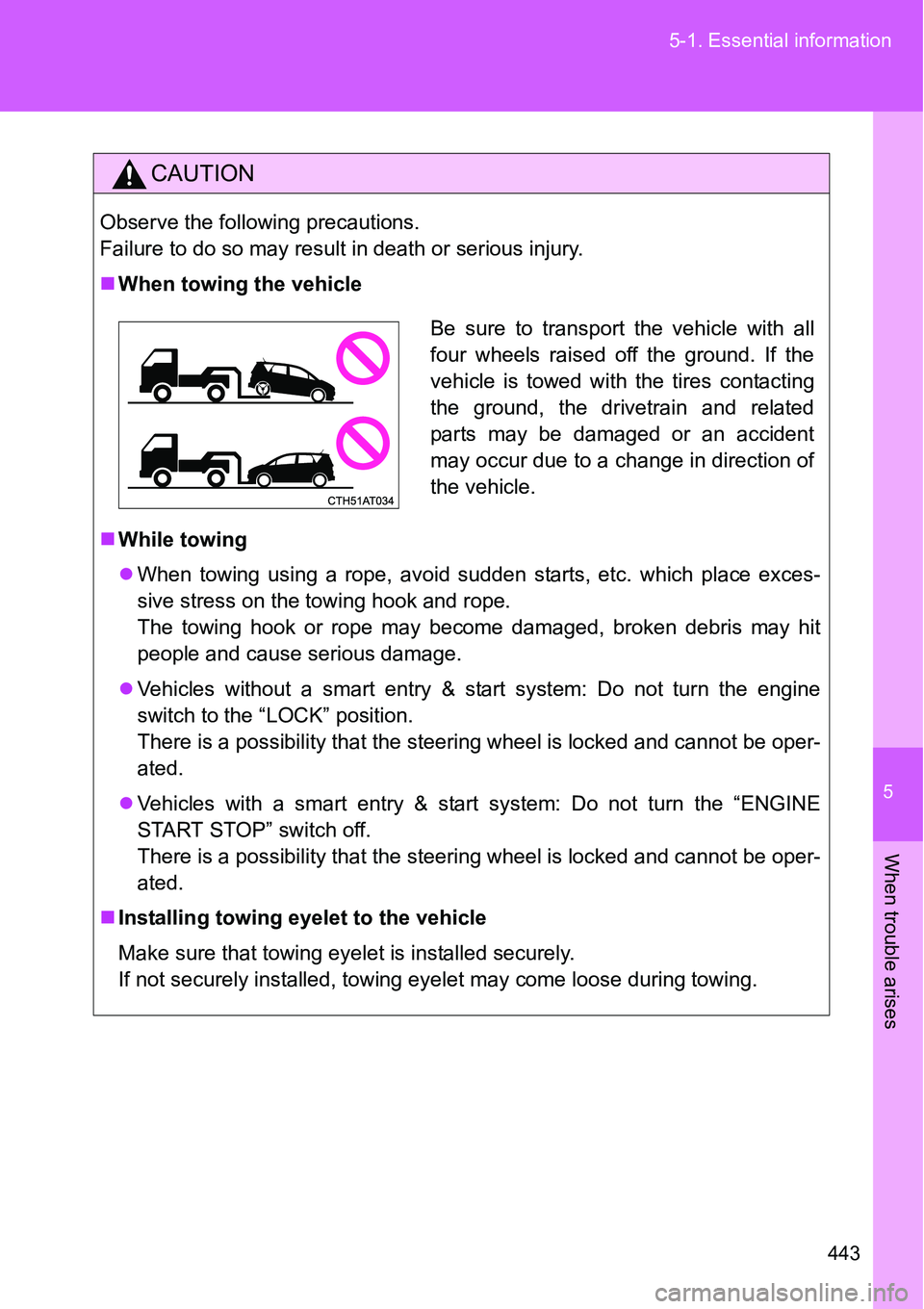Page 373 of 564

373 4-3. Do-it-yourself maintenance
4
Maintenance and care
Adding engine oil
If the oil level is below or near
the low level mark, add engine
oil of the same type as that
already in the engine.
Make sure to check the oil type and prepare the items needed before
adding oil.
Remove the oil filler cap by turning it counterclockwise.
Add engine oil slowly, checking the dipstick.
Install the oil filler cap by turning it clockwise.
Engine oil selectionP. 528
Oil quantity
(Low Full)1.5 L (1.6 qt., 1.3 Imp. qt.)
Item Clean funnel
Engine oil consumption
A certain amount of engine oil will be consumed while driving. In the follow-
ing situations, oil consumption may increase, and engine oil may need to be
refilled in between oil maintenance intervals.
When the engine is new, for example directly after purchasing the vehicle
or after replacing the engine
If low quality oil or oil of an inappropriate viscosity is used
When driving at high engine speeds or with a heavy load, when towing,
or when driving while accelerating or decelerating frequently
When leaving the engine idling for a long time, or when driving frequently
through heavy traffic
STEP1
STEP2
STEP3
Page 437 of 564

5
437
5-1. Essential information
When trouble arises
If your vehicle needs to be towed
Situations needs to contact dealers before towing
The following may indicate a problem with your transmission. Contact
any authorized Toyota dealer or repairer, or another duly qualified
and equipped professional or commercial towing service before tow-
ing.
The engine is running but the vehicle will not move.
The vehicle makes an abnormal sound.
Towing with a sling-type truck
Do not tow with a sling-type truck
to prevent body damage.
If towing is necessary, we recommend having your vehicle towed by
any authorized Toyota dealer or repairer, or another duly qualified
and equipped professional or commercial towing service, using a
lift-type truck or flatbed truck.
Use a safety chain system for all towing, and abide by all state/pro-
vincial and local laws.
If towing your vehicle with a wheel-lift type truck from the front, the
vehicle's rear wheels and axles must be in good conditions.
(P. 438, 443)
If they are damaged, use a towing dolly or flatbed truck.
Page 438 of 564
438 5-1. Essential information
Towing with a wheel-lift type truck
From the front
Release the parking brake.
From the rear
Vehicles with a Multidrive: Use a
towing dolly under the front
wheels.
Vehicles with a manual transmis-
sion: We recommend using a
towing dolly under the front
wheels.
Vehicles without a smart entry &
start system: When not using a
towing dolly, turn the engine
switch to the “ACC” position and
shift the shift lever to N.
Vehicles with a smart entry & start
system: When not using a towing
dolly, turn the “ENGINE START
STOP” switch to ACCESSORY
mode and shift the shift lever to
N.
Page 440 of 564
440 5-1. Essential information
Emergency towing
If a tow truck is not available in
an emergency, your vehicle may
be temporarily towed using a
cable or chain secured to the
emergency towing eyelet. This
should only be attempted on
hard surfaced roads for 80 km
(50 miles) at low speeds.
A driver must be in the vehicle to
steer and operate the brakes.
The vehicle’s wheels, drive train,
axles, steering and brakes must
be in good condition.
For vehicles with a Multidrive,
only the front towing eyelet may
be used.
Page 441 of 564
5
441 5-1. Essential information
When trouble arises
Emergency towing procedure
Take out the towing eyelet. (P. 462, 475)
Press and hold the left side of
the eyelet cover while removing
the cover with a flathead screw-
driver.
To protect the bodywork, place a
rag between the screwdriver and
the vehicle body as shown in the
illustration.
Insert the towing eyelet into the
hole and tighten partially by
hand.
Tighten down the towing eyelet
securely using a wheel nut
wrench.
Securely attach a cable or chain to the towing eyelet.
Take care not to damage the vehicle body.
STEP1STEP6STEP1
STEP2
STEP3
STEP4
STEP1STEP6STEP1STEP5
Page 442 of 564
442 5-1. Essential information
Vehicles without a smart entry & start system: Enter the vehi-
cle being towed and start the engine.
If the engine does not start, turn the engine switch to the “ON”
position.
Vehicles with a smart entry & start system: Enter the vehicle
being towed and start the engine.
If the engine does not start, turn the “ENGINE START STOP”
switch to IGNITION ON mode.
Shift the shift lever to N and release the parking brake.
When the shift lever cannot be shifted: P. 4 9 5
While towing
If the engine is not running, the power assist for the brakes and steering will
not function, making steering and braking more difficult.
Wheel nut wrench
Wheel nut wrench is installed in the tool tray (vehicles with a spare tire) or
the tool box (vehicles with an emergency tire puncture repair kit).
(P. 462, 475)
STEP1STEP6STEP1STEP6
STEP1STEP6STEP1STEP5STEP7
Page 443 of 564

5
443 5-1. Essential information
When trouble arises
CAUTION
Observe the following precautions.
Failure to do so may result in death or serious injury.
When towing the vehicle
While towing
When towing using a rope, avoid sudden starts, etc. which place exces-
sive stress on the towing hook and rope.
The towing hook or rope may become damaged, broken debris may hit
people and cause serious damage.
Vehicles without a smart entry & start system: Do not turn the engine
switch to the “LOCK” position.
There is a possibility that the steering wheel is locked and cannot be oper-
ated.
Vehicles with a smart entry & start system: Do not turn the “ENGINE
START STOP” switch off.
There is a possibility that the steering wheel is locked and cannot be oper-
ated.
Installing towing eyelet to the vehicle
Make sure that towing eyelet is installed securely.
If not securely installed, towing eyelet may come loose during towing.
Be sure to transport the vehicle with all
four wheels raised off the ground. If the
vehicle is towed with the tires contacting
the ground, the drivetrain and related
parts may be damaged or an accident
may occur due to a change in direction of
the vehicle.
Page 444 of 564
444 5-1. Essential information
NOTICE
To prevent damage to the vehicle when towing using a wheel-lift type
truck
When raising the vehicle, ensure adequate ground clearance for towing at
the opposite end of the raised vehicle. Without adequate clearance, the
vehicle could be damaged while being towed.
To prevent body damage when towing with a sling-type truck
Do not tow with a sling-type truck, either from the front or rear.